THine Value V-by-One® HS goes beyond LVDS -Long distance transmission at a high speed is achieved with high reliable 8B/10B coding and signal conditioning technology-
2017.12.12
- Article
- Column
“LVDS (Low Voltage Differential Signaling) SerDes” established an era as the image/video interface for notebook computers, LCD monitors, and LCD TV. Its successor technology is “V-by-One® HS.” Today, it is being adopted for many high-resolution large-screen LCD TV and other devices. It can be said to be one of the technologies that supports the global diffusion of LCD TV behind the scenes. Now, in this third installment, we will explain about the basic principle and features of V-by-One® HS.
LCD TV with higher image quality and larger screens
V-by-One® HS features both high speed and long distance data transmission (Fig. 1).
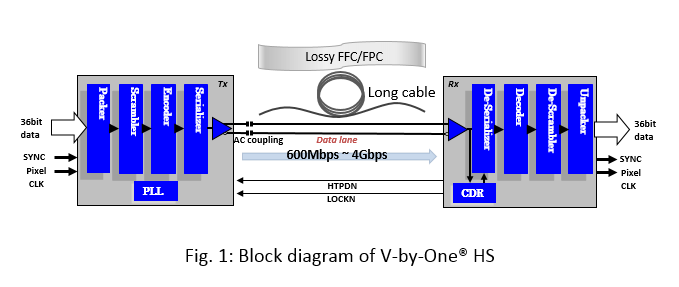 Its maximum data transmission speed is high – 4G bits/sec via a pair of differential lines. The transmission cable length is over 10 meters from serializer to deserializer. In the case of LVDS, on the other hand, the data transmission speed designated by the Standard was up to 655M bits/sec. This speed could be improved by the manufacturers’ own technology, but around one giga bits/sec per lane would be the physical limit because skew between clock and data signals occurs when using LVDS SerDes at this speed. Because of this, even when using very expensive twin-ax cable, data could only be transmitted reliably a maximum distance of five meters with low speed.
Its maximum data transmission speed is high – 4G bits/sec via a pair of differential lines. The transmission cable length is over 10 meters from serializer to deserializer. In the case of LVDS, on the other hand, the data transmission speed designated by the Standard was up to 655M bits/sec. This speed could be improved by the manufacturers’ own technology, but around one giga bits/sec per lane would be the physical limit because skew between clock and data signals occurs when using LVDS SerDes at this speed. Because of this, even when using very expensive twin-ax cable, data could only be transmitted reliably a maximum distance of five meters with low speed.
The reason why V-by-One® HS, the next-generation of LVDS SerDes, became essential is that the image quality of LCD TV improved and its screen grew in size. There are three factors that have an influence on the image quality of LCD TV – the number of pixels (resolution), frame rate, and color depth. If any of them increases or improves, the image quality will be enhanced. On the other hand, however, the image/video data bandwidth increases between the video processing board and the timing controller IC (T-CON) in the liquid crystal display panel. In addition, when LCD TV has a larger screen, the video processing board and T-CON are placed further apart; thus, creating a longer distance for signal transfers.
With the image/video data bandwidth increasing and with the increased length of the signal transmission interface, it became self-evident that the existing LVDS SerDes would reach its limitation sooner or later. Then, when was the shift point from LVDS SerDes to V-by-One® HS? It was the appearance of LCD TV with 2K pixels (1920x1080), a 120Hz frame rate, and a screen size over 42 inches.
 Its maximum data transmission speed is high – 4G bits/sec via a pair of differential lines. The transmission cable length is over 10 meters from serializer to deserializer. In the case of LVDS, on the other hand, the data transmission speed designated by the Standard was up to 655M bits/sec. This speed could be improved by the manufacturers’ own technology, but around one giga bits/sec per lane would be the physical limit because skew between clock and data signals occurs when using LVDS SerDes at this speed. Because of this, even when using very expensive twin-ax cable, data could only be transmitted reliably a maximum distance of five meters with low speed.
Its maximum data transmission speed is high – 4G bits/sec via a pair of differential lines. The transmission cable length is over 10 meters from serializer to deserializer. In the case of LVDS, on the other hand, the data transmission speed designated by the Standard was up to 655M bits/sec. This speed could be improved by the manufacturers’ own technology, but around one giga bits/sec per lane would be the physical limit because skew between clock and data signals occurs when using LVDS SerDes at this speed. Because of this, even when using very expensive twin-ax cable, data could only be transmitted reliably a maximum distance of five meters with low speed. The reason why V-by-One® HS, the next-generation of LVDS SerDes, became essential is that the image quality of LCD TV improved and its screen grew in size. There are three factors that have an influence on the image quality of LCD TV – the number of pixels (resolution), frame rate, and color depth. If any of them increases or improves, the image quality will be enhanced. On the other hand, however, the image/video data bandwidth increases between the video processing board and the timing controller IC (T-CON) in the liquid crystal display panel. In addition, when LCD TV has a larger screen, the video processing board and T-CON are placed further apart; thus, creating a longer distance for signal transfers.
With the image/video data bandwidth increasing and with the increased length of the signal transmission interface, it became self-evident that the existing LVDS SerDes would reach its limitation sooner or later. Then, when was the shift point from LVDS SerDes to V-by-One® HS? It was the appearance of LCD TV with 2K pixels (1920x1080), a 120Hz frame rate, and a screen size over 42 inches.
LVDS needs too many signal lines
Even if the number of pixels is 2K, LVDS SerDes is usable for LCD TV if its frame rate remains at 60Hz, 10bitRGB. Image/Video data can be transmitted via 12 pairs of differential lines, or 24 signal lines (Fig. 2).
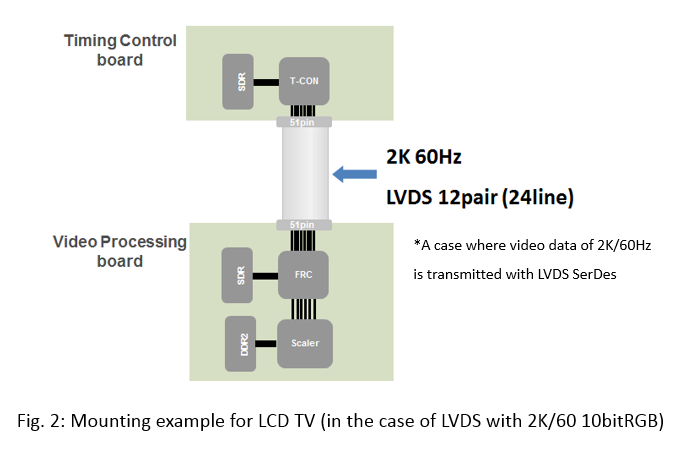
However, if the frame rate increases to 120Hz, the number of differential lines has to double – 48 signal lines in 24 pairs. If the number of pixels expands to 4K (3840 x 2160) with a 120Hz frame rate, the image/video data will quadruple, requiring 192 signal lines in 96 pairs.
192 signal lines for 4K/120Hz would be unfeasible. To connect a video processing board and a T-CON, 50-pin flexible flat cables (FFC) are generally used. In the case of 48 signal lines, one FFC and one connector can serve. But for 192 signal lines in 96 pairs, four FFCs and four connectors are required (Fig. 3).
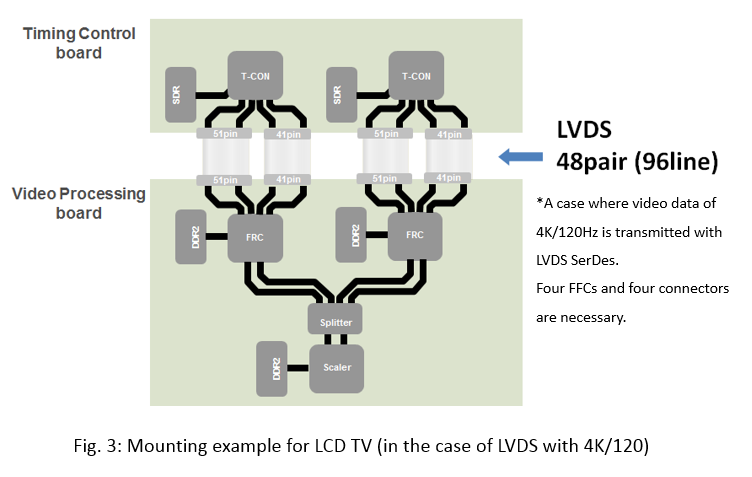
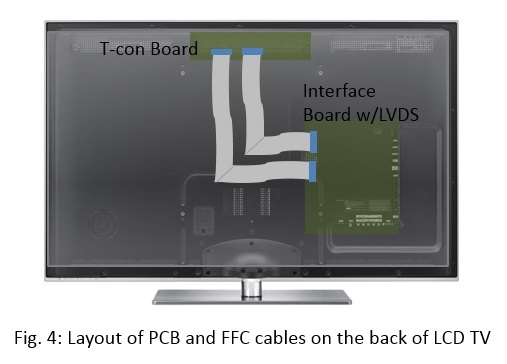 Usually, FFCs are laid out on the backside of the liquid crystal panel (Fig. 4). If the number of FFCs and connectors increases to four each, more space is required on the PCB (printed circuit board) and component costs will go up. To avoid this disadvantage, expansion of mounting space on the PCB is not desired in general.
Usually, FFCs are laid out on the backside of the liquid crystal panel (Fig. 4). If the number of FFCs and connectors increases to four each, more space is required on the PCB (printed circuit board) and component costs will go up. To avoid this disadvantage, expansion of mounting space on the PCB is not desired in general.
When the screen size grows larger to about 42 inches, the cable length between the video processing board and the T-CON gets longer – between 50cm and 70cm. With LVDS SerDes, this causes attenuation of signal amplitude and a skew problem between signals, raising the possibility of failure of proper transmission. In addition, electromagnetic interference (EMI) becomes evident. These problems can be solved if the cable reduces signal loss, skew is corrected, and shielding is provided, but this will increase costs significantly.
This is the background that necessitated the creation of V-by-One® HS. If LVDS SerDes is replaced with V-by-One® HS, only 32 signal lines in 16 pairs is sufficient even for 4K/120Hz, because the data transmission speed per pair is high – 4G bit/sec at the maximum. This means that image/video data can be transmitted with one FFC and one connector (Fig. 5).
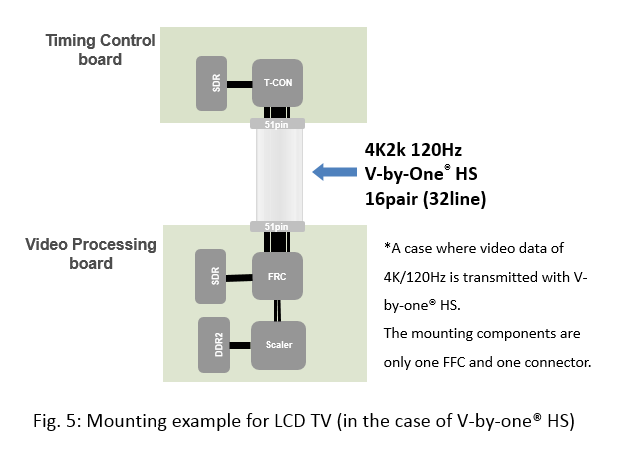
V-by-One® HS makes FFC mounting easier and reduces the costs for PCB and passive components. As EMI noise is lessened, data can be transmitted over distances of more than one meter without error even when using an inexpensive FFC (Fig. 6). Therefore, even if the LCD TV screen grows in size, no problem occurs during data transmission. General-purpose FFC also can be used for the connector.
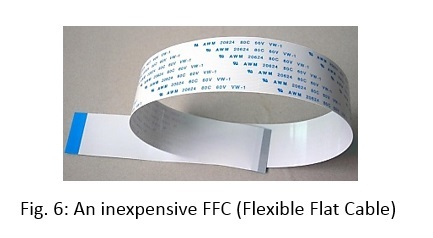

However, if the frame rate increases to 120Hz, the number of differential lines has to double – 48 signal lines in 24 pairs. If the number of pixels expands to 4K (3840 x 2160) with a 120Hz frame rate, the image/video data will quadruple, requiring 192 signal lines in 96 pairs.
192 signal lines for 4K/120Hz would be unfeasible. To connect a video processing board and a T-CON, 50-pin flexible flat cables (FFC) are generally used. In the case of 48 signal lines, one FFC and one connector can serve. But for 192 signal lines in 96 pairs, four FFCs and four connectors are required (Fig. 3).

 Usually, FFCs are laid out on the backside of the liquid crystal panel (Fig. 4). If the number of FFCs and connectors increases to four each, more space is required on the PCB (printed circuit board) and component costs will go up. To avoid this disadvantage, expansion of mounting space on the PCB is not desired in general.
Usually, FFCs are laid out on the backside of the liquid crystal panel (Fig. 4). If the number of FFCs and connectors increases to four each, more space is required on the PCB (printed circuit board) and component costs will go up. To avoid this disadvantage, expansion of mounting space on the PCB is not desired in general. When the screen size grows larger to about 42 inches, the cable length between the video processing board and the T-CON gets longer – between 50cm and 70cm. With LVDS SerDes, this causes attenuation of signal amplitude and a skew problem between signals, raising the possibility of failure of proper transmission. In addition, electromagnetic interference (EMI) becomes evident. These problems can be solved if the cable reduces signal loss, skew is corrected, and shielding is provided, but this will increase costs significantly.
This is the background that necessitated the creation of V-by-One® HS. If LVDS SerDes is replaced with V-by-One® HS, only 32 signal lines in 16 pairs is sufficient even for 4K/120Hz, because the data transmission speed per pair is high – 4G bit/sec at the maximum. This means that image/video data can be transmitted with one FFC and one connector (Fig. 5).

V-by-One® HS makes FFC mounting easier and reduces the costs for PCB and passive components. As EMI noise is lessened, data can be transmitted over distances of more than one meter without error even when using an inexpensive FFC (Fig. 6). Therefore, even if the LCD TV screen grows in size, no problem occurs during data transmission. General-purpose FFC also can be used for the connector.

Two basic technologies create V-by-One® HS
We will explain about the technologies that have realized V-by-One® HS equipped with high transmission properties. There are two technological points.
One is that the clock embedded method is adopted – the method to transmit data signal and clock information via one signal line. With LVDS SerDes, the data signal and clock signal were sent in separate signal lines in what is called the data/clock separate transmission method (Fig. 7).
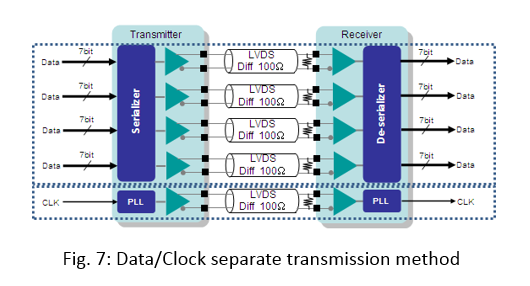 In this method, the de-serializer receives data signals which synchronize with the received clock signal timing, as in the case of the parallel bus system. This has a problem. When transmission speed quickens or cable reach gets longer, skew between the data signal and clock signal increases. If the timing of receiving the data and clock signals lags, data cannot be received properly.
In this method, the de-serializer receives data signals which synchronize with the received clock signal timing, as in the case of the parallel bus system. This has a problem. When transmission speed quickens or cable reach gets longer, skew between the data signal and clock signal increases. If the timing of receiving the data and clock signals lags, data cannot be received properly.
In the clock embedded method, on the other hand, the clock information is embedded in the serial data signal. This enables clock information to be extracted by the CDR (clock data recovery) circuit in the de-serializer and the data signal to be synchronized with the embedded-clock.
With this method, no skew occurs between the data signal and clock signal even if the transmission speed goes up or transmission distance lengthens. This is why data can be transmitted at a higher speed over a longer cable.
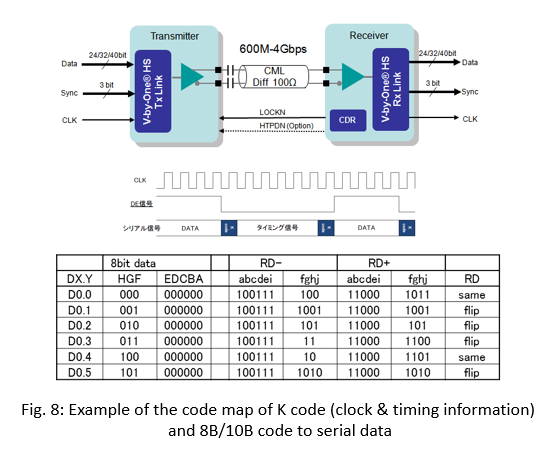 As the means to achieve the clock embedded method, the 8B/10B coding method is adopted for V-by-One® HS – the method to transmit data through converting 8-bit data to 10-bit data (Fig. 8).
As the means to achieve the clock embedded method, the 8B/10B coding method is adopted for V-by-One® HS – the method to transmit data through converting 8-bit data to 10-bit data (Fig. 8).
Additional 2-bit data are used to transmit control code, to limit run length for enhancement of signal quality, and to secure DC balance.
Here, many of you may have a question, “Isn’t the 8B/10B coding unsuitable for faster data transmission because it converts 8-bit signals into 10-bit signals, resulting in 20% overhead?” Indeed, the two bits to be added seem redundant. But thanks to the two bits, inter-symbol interference (ISI) jitter can be reduced when using a long cable. In other words, by implementing the 8B/10B coding, the run length of “0” and “1” signals can be limited to up to five. This makes it possible to remove the low-frequency component if it accounts for less than 20%. Also, the number of “0” and “1” can be controlled to become even. Because of this, when data is transmitted at a high speed over a long distance, eye opening can be easily secured as shown in Fig. 9, achieving high quality transmission characteristics even at a high data transmission speed like 4G bits/sec.
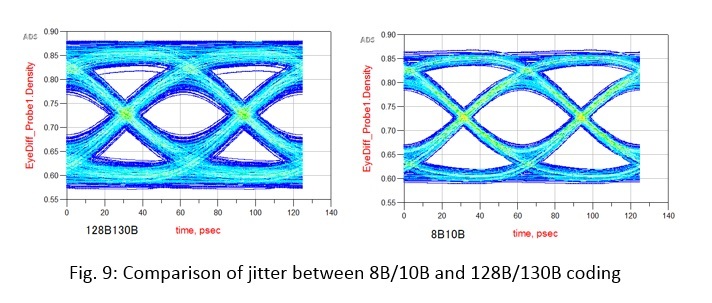
The other point is that signal-conditioning technology is introduced. To be specific, pre-emphasis technology is applied to the serializer and adaptive equalizer technology to the de-serializer.
Pre-emphasis technology is amplitude adjustment of the high frequency component in advance of data output. This compensates for this signal frequency component’s tendency to attenuate during transmission. Adaptive equalizer technology is used to automatically adjust the amplitude of the high frequency component at the de-serializer to deal with variable attenuation in the transmission line. This is done in accordance with the characteristics of the transmission line. Both technologies contribute to the enhancement of transmission characteristics (Fig. 10), making it possible to raise the data transmission speed and, at the same time, to expand the cable reach.

By adopting the 8B/10B coding and signal conditioning technology, V-by-One® HS has achieved extremely high transmission characteristics. As a result, it has won the position of being the “de facto standard” for image/video interfacing for high-resolution LCD TV with high quality image. However, LCD TV and LCD monitors are not the only electronic devices that need sophisticated high transmission characteristics. Many other devices also do. Then, in the case of other electronic devices, how can V-by-One® HS be fully used? This will be explained in detail next time.
One is that the clock embedded method is adopted – the method to transmit data signal and clock information via one signal line. With LVDS SerDes, the data signal and clock signal were sent in separate signal lines in what is called the data/clock separate transmission method (Fig. 7).
 In this method, the de-serializer receives data signals which synchronize with the received clock signal timing, as in the case of the parallel bus system. This has a problem. When transmission speed quickens or cable reach gets longer, skew between the data signal and clock signal increases. If the timing of receiving the data and clock signals lags, data cannot be received properly.
In this method, the de-serializer receives data signals which synchronize with the received clock signal timing, as in the case of the parallel bus system. This has a problem. When transmission speed quickens or cable reach gets longer, skew between the data signal and clock signal increases. If the timing of receiving the data and clock signals lags, data cannot be received properly.In the clock embedded method, on the other hand, the clock information is embedded in the serial data signal. This enables clock information to be extracted by the CDR (clock data recovery) circuit in the de-serializer and the data signal to be synchronized with the embedded-clock.
With this method, no skew occurs between the data signal and clock signal even if the transmission speed goes up or transmission distance lengthens. This is why data can be transmitted at a higher speed over a longer cable.
 As the means to achieve the clock embedded method, the 8B/10B coding method is adopted for V-by-One® HS – the method to transmit data through converting 8-bit data to 10-bit data (Fig. 8).
As the means to achieve the clock embedded method, the 8B/10B coding method is adopted for V-by-One® HS – the method to transmit data through converting 8-bit data to 10-bit data (Fig. 8). Additional 2-bit data are used to transmit control code, to limit run length for enhancement of signal quality, and to secure DC balance.
Here, many of you may have a question, “Isn’t the 8B/10B coding unsuitable for faster data transmission because it converts 8-bit signals into 10-bit signals, resulting in 20% overhead?” Indeed, the two bits to be added seem redundant. But thanks to the two bits, inter-symbol interference (ISI) jitter can be reduced when using a long cable. In other words, by implementing the 8B/10B coding, the run length of “0” and “1” signals can be limited to up to five. This makes it possible to remove the low-frequency component if it accounts for less than 20%. Also, the number of “0” and “1” can be controlled to become even. Because of this, when data is transmitted at a high speed over a long distance, eye opening can be easily secured as shown in Fig. 9, achieving high quality transmission characteristics even at a high data transmission speed like 4G bits/sec.

The other point is that signal-conditioning technology is introduced. To be specific, pre-emphasis technology is applied to the serializer and adaptive equalizer technology to the de-serializer.
Pre-emphasis technology is amplitude adjustment of the high frequency component in advance of data output. This compensates for this signal frequency component’s tendency to attenuate during transmission. Adaptive equalizer technology is used to automatically adjust the amplitude of the high frequency component at the de-serializer to deal with variable attenuation in the transmission line. This is done in accordance with the characteristics of the transmission line. Both technologies contribute to the enhancement of transmission characteristics (Fig. 10), making it possible to raise the data transmission speed and, at the same time, to expand the cable reach.

By adopting the 8B/10B coding and signal conditioning technology, V-by-One® HS has achieved extremely high transmission characteristics. As a result, it has won the position of being the “de facto standard” for image/video interfacing for high-resolution LCD TV with high quality image. However, LCD TV and LCD monitors are not the only electronic devices that need sophisticated high transmission characteristics. Many other devices also do. Then, in the case of other electronic devices, how can V-by-One® HS be fully used? This will be explained in detail next time.
Related Contents
- Higher Refresh Rates and Lower Power Consumption for TVs! Introducing the V-by-One HS plus Standard
- The technology of V-by-One® SerDes apply not only to TV application but to high-speed interfaces for communication/computer/industrial equipment as well
- V-by-One® HS goes beyond LVDS, making its presence known in medical, automotive and various other applications
- Deep dive about the Basic Principle of LVDS SerDes, Taking advantage of its features – high speed, long distance, low noise
- History of THine products for signal transmission started from SerDes IC for laptop PC
